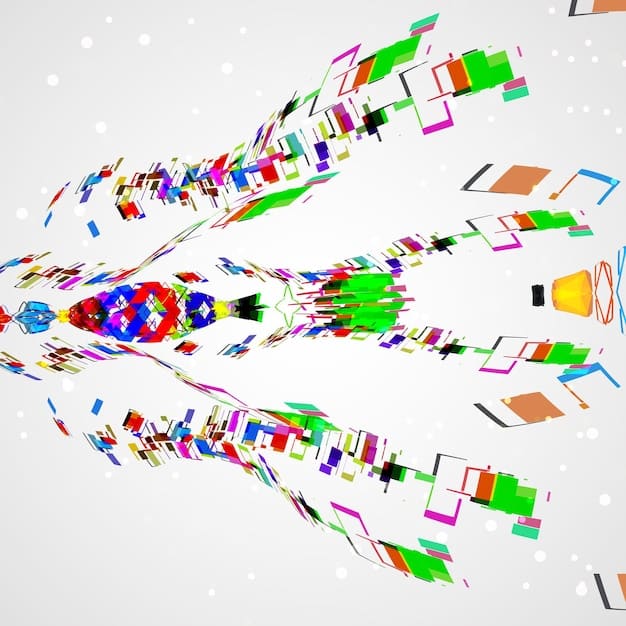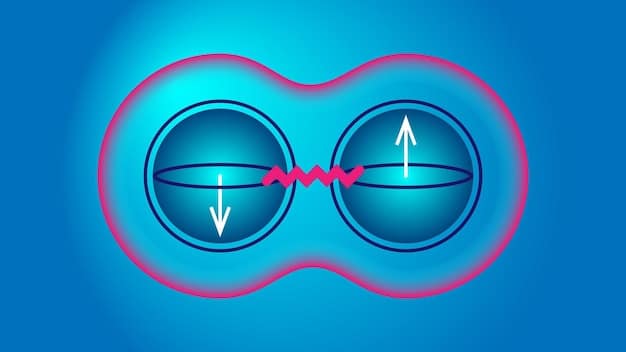Is Your Game’s Collision Detection Costing You 15% Performance? Optimize Now!

Optimizing your game’s collision detection algorithms can significantly boost performance, potentially reclaiming up to 15% of processing power, by refining how objects interact within the game engine.
Is your game’s collision detection costing you 15% performance? Optimize now! This question resonates deeply with game developers striving for flawless gameplay and peak efficiency. Unoptimized collision systems can silently cripple your game’s framerate, leading to frustrating lag and a subpar user experience. Understanding the nuances of collision detection, from its foundational principles to advanced optimization techniques, is crucial for unlocking your game’s full potential.
understanding collision detection fundamentals
Collision detection forms the bedrock of interactive game experiences, determining when and how physical objects within a virtual environment interact. It’s the silent workhorse that ensures characters don’t pass through walls, bullets hit targets, and cars crash realistically. Without robust collision detection, a game world would devolve into a chaotic, non-interactive visual spectacle.
At its core, collision detection involves algorithms that test for overlaps between the geometric shapes of game objects. These shapes, often simplified representations of the actual visual models, are known as colliders. The precision and complexity of these colliders directly influence both the accuracy of collision responses and, crucially, the computational cost. A common misconception is that rendering complexity directly correlates with collision complexity, but often, simplified bounding volumes are used for efficiency, even with visually intricate models.
what are bounding volumes?
Bounding volumes are simplified geometric shapes used to approximate the more complex geometry of game objects for collision detection purposes. They encapsulate an object, providing a less detailed, but computationally cheaper, representation for initial collision checks. This hierarchical approach significantly reduces the number of precise (and expensive) polygon-level checks needed.
- Axis-Aligned Bounding Boxes (AABBs): These are boxes aligned with the world’s coordinate axes. They are incredibly simple to work with and computationally cheap to test for overlaps, making them ideal for broad-phase collision detection. However, their fixed alignment means they can be a poor fit for rotated objects, leading to excessive “empty” space and false positives.
- Oriented Bounding Boxes (OBBs): Unlike AABBs, OBBs can be arbitrarily rotated to fit an object’s geometry more tightly. This reduces the amount of empty space around the object but increases the complexity of overlap tests. They offer a good balance between fit and computational cost for many scenarios.
- Bounding Spheres/Circles: These are the simplest bounding volumes, offering very fast overlap tests (just checking the distance between centers against the sum of radii). They are perfect for broad-phase checks but suffer from a very loose fit for non-spherical objects, leading to many false positives.
- Capsules: Essentially a cylinder with hemispherical caps, capsules provide a tighter fit than spheres for elongated objects and are relatively simple to test against, commonly used for character controllers.
The choice of bounding volume is a critical early optimization. Selecting the simplest bounding volume that sufficiently approximates an object’s shape can yield significant performance benefits, particularly when dealing with a large number of objects in a scene. The goal is to perform cheap, coarse-grained checks first, eliminating most non-colliding pairs, before moving to more expensive, fine-grained checks.
Understanding these fundamental concepts is the first step toward building an efficient collision system. The interplay of bounding volumes, broad-phase, and narrow-phase techniques underpins almost every successful game engine’s approach to interaction, and any significant performance drain often traces back to inefficiencies in these initial stages.
broad-phase vs. narrow-phase collision detection
Collision detection is a two-stage process designed to minimize computational overhead. It begins with a broad-phase check, quickly identifying potential collision pairs, and is followed by a more precise narrow-phase check for actual intersections. This division of labor is crucial for performance, especially in games with many interacting objects.
Imagine a bustling city street. The broad phase is like a quick scanner that identifies all cars that are even remotely close to each other. It doesn’t care if they’ve actually hit, just that they’re in the same general vicinity. Only those “nearby” cars then undergo a more detailed inspection in the narrow phase to see if their bumpers are actually touching. This two-tier system avoids the costly process of minutely checking every single object against every other single object in a large scene.
optimizing the broad phase
The broad phase is about culling. Its primary goal is to drastically reduce the number of potential collision pairs that need to be subjected to the more expensive narrow-phase calculations. Effective broad-phase algorithms can eliminate 99% or more of non-colliding pairs, making it the most impactful area for initial performance gains.
- Spatial Hashing: This technique divides the world into a grid of cells. Each object is placed into the cells it occupies. When checking for collisions, an object only needs to check other objects within its own cell and neighboring cells. This works well for dynamic environments where objects move frequently.
- Grids/Octrees/Quadtrees: Similar to spatial hashing, these structures partition space hierarchically. Quadtrees are used for 2D worlds, Octrees for 3D worlds. Objects are stored in the smallest node that fully contains them. Collision checks traverse the tree, only inspecting objects in relevant nodes. These are very effective for static or semi-static environments.
- Sweep and Prune (SAP) / Sort and Sweep: This method projects the bounding boxes of objects onto each axis (X, Y, Z). It then sorts these projections along each axis. Potential overlaps are identified by traversing the sorted lists. This is particularly efficient when many objects are moving in the same general direction or when the environment is largely static, as the sorted lists can be updated incrementally.
The choice of broad-phase algorithm depends heavily on the characteristics of your game world. A highly dynamic world with many small, fast-moving objects might benefit more from spatial hashing, while a largely static world with large, slow-moving objects could find better performance with octrees or sweep and prune. Benchmarking different approaches with your specific game data is vital to determine the most effective strategy.
Once the broad phase has identified a manageable list of potential collision pairs, the narrow phase takes over. This stage involves precise geometric tests between the actual colliders of the selected pairs to determine if an intersection has truly occurred. The efficiency of your broad-phase dictates how much work your narrow-phase has to do, directly impacting overall performance.
the precision of narrow-phase detection
After the broad-phase filters out non-colliding pairs, the narrow-phase steps in to perform precise intersection tests on the remaining potential collisions. This stage is where the rubber meets the road, identifying exact contact points, normals, and penetration depths, which are crucial for realistic physics responses. While broad-phase concerns efficiency, narrow-phase prioritizes accuracy.
The complexity of narrow-phase algorithms scales with the complexity of the colliders being tested. Testing two spheres is trivial, involving a simple distance calculation. Testing complex polygonal meshes, however, requires significantly more computational power and sophisticated algorithms. This is why careful collider selection is paramount; using simplified colliders in the narrow-phase wherever possible can dramatically reduce processing time without sacrificing perceived accuracy.
common narrow-phase algorithms
Various algorithms are employed in the narrow phase, each suited for different collider types and offering varying levels of precision and performance. The choice is often a trade-off between speed and accuracy, tailored to the specific needs of the game.
- Separating Axis Theorem (SAT): A powerful and widely used algorithm for testing convex shapes (boxes, polygons, spheres, capsules). SAT works on the principle that if two convex shapes are not overlapping, there exists an axis on which their projections do not overlap. The algorithm tests a finite set of such potential separating axes. It’s highly robust and provides a lot of information, including minimum translation vectors for collision resolution.
- GJK (Gilbert–Johnson–Keerthi) Algorithm: This algorithm efficiently determines the distance between two convex shapes. If the distance is zero or negative, an intersection has occurred. GJK is known for its speed and its ability to handle any pair of convex shapes. It’s often paired with EPA (Expanding Polytope Algorithm) to extract collision details like penetration depth and normal.
- Minkowski Sum: While not a direct collision detection algorithm, the concept of the Minkowski sum is central to GJK and SAT. It involves combining two shapes by adding every point of one shape to every point of another. If the origin is contained within the Minkowski difference (a variant of the sum), then the two original shapes intersect.

For more complex, non-convex shapes, a common strategy is to decompose them into multiple convex shapes. Each convex component is then tested against others using algorithms like SAT or GJK. Alternatively, some engines use mesh-to-mesh collision detection, which is the most accurate but also the most computationally expensive, typically reserved for critical interactions or static environment geometry. The key takeaway for narrow-phase optimization is to use the simplest algorithm and collider combination that meets your game’s requirements for fidelity.
The intricate dance between broad-phase and narrow-phase is what makes modern game worlds feel so responsive. Missteps in either can lead to performance bottlenecks, dropped frames, and a less immersive player experience. Investing time in understanding and optimizing both stages is paramount for any serious game developer aiming for peak performance.
optimizing collision performance: practical strategies
Achieving optimal collision performance goes beyond merely selecting the right algorithms; it involves a holistic approach to how collisions are managed throughout the game’s lifecycle. Many subtle factors can cumulatively lead to significant performance drains, often masked until the game world becomes complex. Proactive optimization involves intelligent design choices and tactical implementation.
One of the most common pitfalls is over-engineering. Developers often apply high-precision collision detection to every object, regardless of its importance or interaction frequency. For instance, a small, ambient particle effect doesn’t need to be meticulously checked against every static environmental mesh. Identifying which objects genuinely require precise collision and which can get by with more basic, cheaper checks is a fundamental step.
reducing the number of collision checks
The most effective way to improve collision performance is to reduce the number of checks performed. This requires intelligent culling and filtering, ensuring that the collision system only processes what’s absolutely necessary.
- Layer-Based Filtering: Implement a system where objects belong to different collision layers (e.g., “Player”, “Enemy”, “Environment”, “Projectile”). Define which layers can collide with each other. For example, “Projectile” might collide with “Enemy” and “Environment”, but not with other “Projectile” objects. This is a very powerful and easy-to-implement optimization found in most modern game engines.
- Static vs. Dynamic Objects: Separate static (non-moving) objects from dynamic (moving) objects. Static objects only need to be added to spatial partitioning structures once. Dynamic objects need frequent updates. Collisions between two static objects rarely need to be checked after initial setup, significantly reducing ongoing computational load.
- Disable Collisions When Not Needed: For objects that are temporarily inactive, off-screen, or irrelevant to current gameplay, disable their collision components. A character currently in a cutscene might not need active collision, or faraway NPCs could have their collision detection paused until the player approaches.
- Optimized Collider Shapes: Always use the simplest collider shape that satisfactorily approximates your object’s geometry. For a simple character, a capsule might be more efficient and accurate than a complex mesh collider. For a tree, a simple cylinder or even a set of spheres might suffice instead of intricate branch-level collision, unless complex interactions are specifically required.
Beyond these, consider the frequency of checks. Not every object needs to be checked for collisions every single frame. For slow-moving objects or environmental hazards, checks can be performed at a lower frequency (e.g., every 5th frame), further alleviating the computational burden without a noticeable degradation in user experience. This asynchronous approach can smooth out performance spikes.
The cumulative effect of these small optimizations can be substantial. A game with hundreds or thousands of active objects can quickly become CPU-bound if even a fraction of them are undergoing unnecessary collision checks or using overly complex collider geometries. Effective optimization means designing with performance in mind from the ground up, not as an afterthought.
profiling and debugging collision bottlenecks
Identifying collision performance bottlenecks is often a black art without the right tools. Modern game engines provide sophisticated profiling tools that visualize CPU and GPU usage, allowing developers to pinpoint exactly where precious milliseconds are being spent. Neglecting these tools means flying blind, leading to speculative optimizations that may or may not address the real problem.
Profiling involves systematically measuring the performance of different parts of your game code during runtime. For collision detection, this means tracking the time spent in broad-phase algorithms, narrow-phase checks, and collision response calculations. A sudden spike in CPU usage when many objects interact is a clear indicator that collision is a potential culprit.
tools and techniques for analysis
Effective debugging of collision systems requires more than just looking at numbers; it demands visualization and a methodical approach to isolating problematic areas.
- Engine Profilers: Unity’s Profiler, Unreal Engine’s Session Frontend, and custom tools in proprietary engines offer detailed breakdowns of CPU time. Look for “Physics,” “Collision,” or “Broadphase” sections consuming a disproportionate amount of time. These tools can often show specific functions or even line numbers causing the bottleneck.
- Visual Debugging: Most engines allow visualizing colliders within the editor during runtime. This is invaluable. Are your colliders too complex? Are objects using precise mesh colliders when simple primitives would suffice? Are broad-phase regions (like spatial hash cells or octree nodes) being correctly populated? Visualizing these can reveal issues like unnecessary overlaps or misaligned bounding boxes. Tools like Physics Debugger in Unity or the built-in debug renderers in Unreal allow developers to see the actual shape and position of colliders, active collision layers, and even visualize swept collision paths.
- Statistical Logging: Implement your own logging for collision events. Track the number of broad-phase pairs generated, the number of narrow-phase intersections, and the average time taken for each. Sudden increases in these metrics correlated with performance drops point directly to collision overloads.
- Isolate and Test: If you suspect a particular game system or object type is causing issues, temporarily disable it or reduce its complexity in a test environment. If performance recovers, you’ve found your culprit. This iterative process of isolation and testing is fundamental to debugging.

Sometimes, the issue isn’t the collision algorithm itself, but how objects are managed. Are objects being created and destroyed excessively, leading to collider re-initialization overhead? Are objects being moved without properly updating their spatial partitioning data? Profiling helps distinguish between algorithmic inefficiency and poor object management practices.
Debugging collision issues can be daunting due to their complex, often-interdependent nature. However, with the right profiling tools and a systematic approach, what seems like an intractable performance mystery can often be solved with targeted optimizations, bringing your game closer to its performance targets.
advanced collision optimization techniques
For games pushing the boundaries of complexity or those requiring extremely high performance, standard optimization techniques might not be enough. Advanced collision optimization often involves more specialized data structures, custom algorithms, and a deeper integration with the game’s specific needs. These techniques aim to eke out every last bit of performance, typically at the cost of increased implementation complexity.
One such technique is continuous collision detection (CCD), which prevents “tunneling” – where fast-moving objects pass through thin objects without registering a collision. Instead of checking at discrete timesteps, CCD extrapolates the object’s path and calculates the exact time of impact, ensuring no collisions are missed. While crucial for accurate physics in fast-paced games, it is significantly more computationally intensive than discrete detection.
specialized approaches and custom solutions
- Multithreading and Parallelization: Collision detection is often highly parallelizable. Broad-phase checks and even many narrow-phase checks for different pairs can be run concurrently on multiple CPU cores. Task-based or job-based systems can distribute collision calculations across threads, significantly speeding up the process, especially with many objects. This is a common approach in modern engines.
- GPU-Based Collision Detection: For extremely large numbers of simple objects (e.g., particles, crowd simulation), some broad-phase or even simplified narrow-phase checks can be offloaded to the GPU. GPUs excel at parallel computations, making them ideal for processing thousands of simple collision queries simultaneously. While complex to implement, this can dramatically scale collision capabilities.
- Custom Physics Solvers/Collision Libraries: Instead of relying solely on built-in engine physics, highly specialized games might integrate or even write their own compact collision libraries optimized for specific object types (e.g., specific racing game physics, or very particular fight game hitboxes). This extreme level of customization allows for maximum performance tuning for a niche application.
- Level of Detail (LOD) for Colliders: Similar to visual LOD, colliders can also have different levels of detail. Faraway objects might use simpler bounding volumes (e.g., a sphere), while closer objects switch to more complex ones (e.g., a tighter AABB or OBB), and only the closest objects use precise mesh colliders. This dynamically adjusts collision fidelity based on distance and importance.
Consider a large open-world game. Instead of one monolithic physics world, it might be divided into multiple “physics sub-worlds” or regions. Only objects within (and near) the currently active region are subject to full collision processing, with less important regions or distant objects using simplified or disabled collision. This streaming approach for physics can alleviate pressure on the CPU greatly.
Implementing these advanced techniques requires a deep understanding of game engine architecture, parallel programming, and often, low-level mathematics. They are not typically the first line of defense for performance issues but become indispensable when conventional methods are exhausted. The benefits, however, can be transformative, allowing for richer, more complex interactive environments that would otherwise be impossible.
the future of real-time collision detection
As hardware continues to evolve and open-world games become more ambitious, the demands on real-time collision detection are escalating. The future points towards increasingly sophisticated and automated systems, leveraging AI and machine learning, alongside continuous improvements in parallel processing and data structures. The days of purely manual collision optimization might slowly fade as engines become smarter.
One emerging trend is the use of neural networks to predict potential collisions or optimize broad-phase culling. While still in nascent stages for real-time applications, the idea is that an AI could learn common patterns of object movement and interaction, intelligently predicting which collision checks are most likely to yield a positive result, thereby reducing unnecessary computations.
emerging technologies and trends
- Hardware Acceleration for Physics: Dedicated physics processing units (PPUs) had a brief moment, but their functionality has largely been absorbed by general-purpose GPUs and multi-core CPUs. However, as specialized hardware for AI and ray tracing becomes more common, similar accelerators focused on physics calculations (potentially integrating collision detection at a silicon level) could re-emerge.
- Data-Oriented Design (DOD): This paradigm focuses on optimizing data layout and access patterns for maximum CPU cache efficiency. Applying DOD principles to collision data (e.g., storing all collider positions in a contiguous array) can lead to significant speedups, as processors spend less time waiting for data to load from main memory. Many modern engines are moving towards this.
- Procedural Generation and Collision: As games increasingly rely on procedural generation for vast worlds, collision systems must adapt. Future systems will need to dynamically generate and optimize collision data for streaming, on-the-fly environments, rather than relying on pre-baked data. This involves efficient run-time meshing and collider generation.
- Adaptive Collision Resolution: Beyond just detection, future systems may dynamically adjust the fidelity of collision resolution based on context. For example, a minor graze might get a simple push-back, while a head-on impact at high speed might trigger a more complex, multi-contact impulse calculation, optimizing for perceived realism where it matters most.
The integration of physics and rendering through technologies like Nanite in Unreal Engine 5 or sparse voxel octrees (SVOs) could also revolutionize collision. If rendering and collision data share a unified, highly optimized data structure, it opens doors for extremely detailed and efficient collision checks directly on high-fidelity models, blurring the lines between visual and physical representation. This could potentially eliminate the need for simplified bounding volumes entirely in some contexts.
The landscape of real-time interaction is constantly evolving, driven by both creative ambition and technological innovation. While the core principles of collision detection remain constant, the tools and techniques to achieve it efficiently are on a trajectory towards greater automation, smarter algorithms, and deeper hardware integration, promising even more immersive and responsive game worlds in the years to come.
| Key Optimization | Brief Description |
|---|---|
| 💡 Simplify Colliders | Use basic shapes (spheres, cubes) when possible to reduce computational load. |
| ➕ Layer Filtering | Define which object types can collide, preventing unnecessary checks. |
| ⚡ Broad-Phase Efficiency | Employ spatial data structures like Octrees or SAP to quickly cull non-colliding pairs. |
| 📊 Profile Regularly | Use engine profilers to identify and address specific performance bottlenecks. |
frequently asked questions about collision optimization
Broad-phase collision detection is the initial stage of collision processing that quickly culls objects that are definitely not colliding. It uses simplified bounding volumes and spatial partitioning techniques (like Octrees or Spatial Hashing) to identify potential collision pairs, dramatically reducing the number of precise checks needed in the narrow phase.
Collision detection can be performance-intensive due to the need to check every object against every other object, which scales quadratically with the number of objects. Complex geometries and precise calculations for contact points and normals add significant computational overhead. Unoptimized systems lead to excessive checks and calculations, consuming valuable CPU cycles.
While mesh colliders provide the most accurate representation of an object’s visual geometry, they are also the most computationally expensive. Using them for every dynamic object is highly discouraged as it will severely impact performance. They are best reserved for static environment geometry or for precise, critical interactions where no simpler collider suffices.
“Tunneling” occurs when a fast-moving object passes completely through another object without registering a collision. This happens because collision checks are typically performed at discrete time steps. If an object moves far enough between two frames, it can “jump” over or through another collider. Continuous Collision Detection (CCD) is used to prevent this by sweeping for intersections along the object’s path.
Layer-based collision filtering allows you to define which object layers (or groups) can interact with each other. By explicitly stating that projectiles don’t collide with other projectiles, or that player characters don’t collide with non-interactive decorative elements, you significantly reduce the number of potential collision pairs that the system needs to process, leading to substantial performance gains.
conclusion
Optimizing collision detection is not just about making your game run smoother; it’s about unlocking its full potential. From understanding the core principles of broad-phase and narrow-phase detection to implementing practical strategies like collider simplification and layer filtering, every step contributes to a more responsive and immersive experience. Embracing profiling tools and staying abreast of advanced techniques and future trends empowers developers to conquer performance bottlenecks, ensuring that collision systems enhance, rather than hinder, the player’s journey. By proactively addressing these critical aspects, you can indeed reclaim that valuable 15% (or more!) performance, delivering a polished and professional product to your audience.





